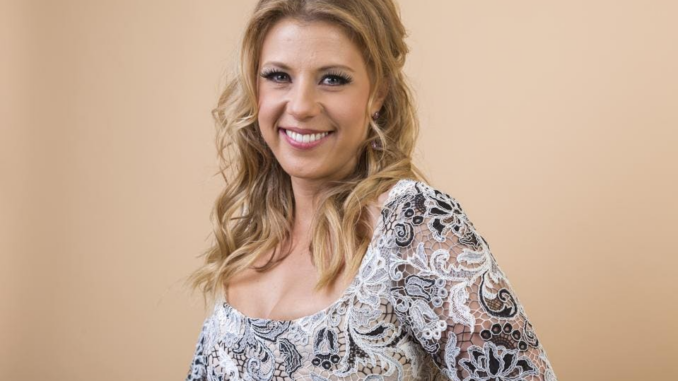
When you think of Full House, words like “wholesome,” “family-friendly,” and “timeless” probably come to mind. The show, which aired from 1987 to 1995, captured hearts with its lovable characters and heartfelt lessons. But recently, Jodie Sweetin, known for playing Stephanie Tanner, made waves by sharing her thoughts on the possible sexual orientations of the characters. Her candid comments have sparked conversations about representation in classic TV shows and how modern audiences view them through a new lens.
Let’s unpack Sweetin’s bold declaration and explore what it means for Full House fans, LGBTQ+ representation, and the evolving world of television.
Revisiting ‘Full House’ Through a Modern Lens
Why Sweetin’s Declaration Matters
Jodie Sweetin’s statement isn’t just a casual remark—it’s a reflection of how society’s understanding of identity has progressed. Her openness invites fans to reimagine a show they’ve cherished for decades and consider how it might resonate differently today.
Nostalgia Meets Representation
For many, Full House is a comforting trip down memory lane. Sweetin’s perspective encourages viewers to look beyond the nostalgia and see the characters as complex individuals who might represent diverse identities.

Breaking Down Jodie Sweetin’s Bold Statement
What Did She Actually Say?
In a recent interview, Sweetin hinted that some Full House characters could be interpreted as part of the LGBTQ+ community. While she didn’t name specific characters, her comments opened the door for fans to speculate and engage in meaningful discussions.
Sparking Conversations About LGBTQ+ Representation
Sweetin’s statement highlights an important issue: the lack of explicit LGBTQ+ representation in classic TV shows. While Full House was groundbreaking in many ways, it largely reflected the cultural norms of its time.
Fans’ Reactions to Sweetin’s Viewpoint
The fanbase has responded with a mix of excitement and curiosity. Many appreciate Sweetin’s willingness to challenge the status quo and bring a fresh perspective to a beloved series.
Representation in Classic TV: Then and Now
The Evolution of LGBTQ+ Representation
Television has come a long way since the 1980s and ’90s. While Full House focused on traditional family dynamics, modern shows are more inclusive, reflecting a broader spectrum of identities and experiences.
Why Representation Matters
Representation isn’t just about visibility—it’s about validation. Seeing diverse characters on screen helps viewers feel seen and understood, creating a sense of belonging.
Reimagining ‘Full House’ Characters
Who Could Sweetin Be Referring To?
While Sweetin didn’t specify, fans have speculated about several characters:
- Uncle Jesse: Could his sensitivity and artistic nature suggest a more fluid identity?
- Danny Tanner: His nurturing personality and dedication to family might hint at deeper layers.
- Kimmy Gibbler: Her quirky, unapologetic personality could align with themes of self-expression.
The Power of Interpretation
One of the beautiful things about art is its ability to be reinterpreted. Sweetin’s comments remind us that viewers can find their own meanings in the stories they love.
The Cultural Impact of ‘Full House’
A Show That Shaped Generations
Full House wasn’t just a sitcom; it was a cultural phenomenon. Its themes of love, forgiveness, and family continue to resonate with audiences worldwide.
Why Sweetin’s Statement Adds Depth
By introducing the possibility of diverse identities, Sweetin adds a new layer of relevance to the show, ensuring it continues to spark conversations for years to come.
Looking Ahead: What This Means for TV
Encouraging Inclusivity in Reboots
As reboots like Fuller House gain popularity, Sweetin’s comments could influence how future episodes address representation. Could we see more diverse storylines in the Tanner family’s next chapter?
Lessons for Modern Creators
Sweetin’s perspective is a reminder for today’s TV creators to prioritize inclusivity and authenticity, ensuring that every viewer feels represented.
Conclusion: A Bold New Chapter for ‘Full House’
Jodie Sweetin’s declaration about Full House characters’ sexual orientations is more than a passing comment—it’s a call to action. It challenges fans to think critically about the shows they love and encourages creators to embrace diversity in storytelling.
As society continues to evolve, so does our understanding of identity and representation. Sweetin’s words remind us that even the most timeless stories can grow and change, resonating with new generations in unexpected ways.
FAQs
Q1: What did Jodie Sweetin say about ‘Full House’ characters?
A: Sweetin suggested that some characters could be interpreted as part of the LGBTQ+ community, sparking discussions about representation in classic TV.
Q2: Did ‘Full House’ ever address LGBTQ+ themes?
A: Not explicitly. The show largely reflected the cultural norms of its time, focusing on traditional family dynamics.
Q3: How have fans reacted to Sweetin’s comments?
A: Many fans are excited about the fresh perspective and appreciate the opportunity to revisit the show with a more inclusive lens.
Q4: Will ‘Fuller House’ explore these themes?
A: It’s unclear, but Sweetin’s comments could influence future storylines if the reboot continues.
Q5: Why is LGBTQ+ representation in classic TV important?
A: Revisiting classic shows through a modern lens helps validate diverse identities and ensures that timeless stories remain relevant.
